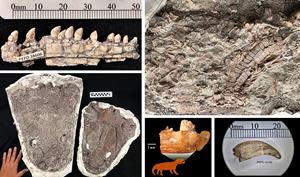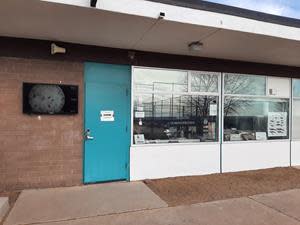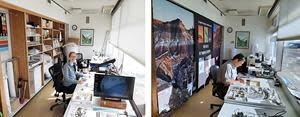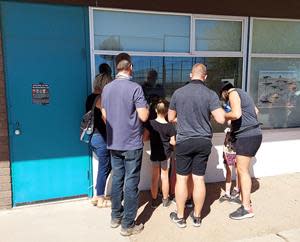Small but Mighty: Petrified Forest National Park’s Public Fossil Preparation Lab Grows Despite COVID-19 Pandemic

Collection of notable fossil projects worked on in the Museum Demonstration Lab

Demo Lab

Demo Lab View

Demo Lab set up March 2020 (left) and February 2022 (right)

Demo Lab Visitors

Petrified Forest National Park
Diana Boudreau, Fossil Preparator
Petrified Forest National Park, Arizona
PETRIFIED FOREST, Ariz., May 26, 2022 (GLOBE NEWSWIRE) -- Along Interstate 40, situated between the New Mexico border and Winslow, Arizona, sits the Painted Desert Visitors Center (PDVC) at the north end of Petrified Forest National Park. Its location draws in hundreds of thousands of travelers every year driving across the country in everything from tiny cars to giant U-Haul trucks. The PDVC provides a respite from the open road and a break from travels. But once visitors pass through the central courtyard, following the signs to the Museum Demonstration Lab, they embark on a different journey that takes them back in time.
The Museum Demonstration Lab (Demo Lab) is a space specifically designed to bring the paleontological discoveries and museum collections of Petrified Forest into public view. Paleontologists at Petrified Forest actively work with academic partners to reconstruct a detailed history of life during the Late Triassic, and exciting new research has resulted in the publication of multiple scientific manuscripts in just the last few years (e.g., Marsh et al. 2020; Kligman et al. 2021; Parker et al. 2021a, 2021b). The Demo Lab has been THE primary place for park staff to share these scientific discoveries with the public, often showcasing the fossils themselves before they even go on exhibit or into collections. Although commonly found Late Triassic fossils, such as phytosaurs and metoposaurs, can be seen on the bench in the Demo Lab, it is more likely that new and significant specimens are being prepared, housed, or exhibited for the public.

Collection of notable fossil projects worked on in the Museum Demonstration Lab. Clockwise from top left: Azendohsaur dentary (PEFO 38606); Revueltosaurus field jacket (PEFO 42442); Skybalonyx skapter claw (PEFO 43703); Kataigidodon venetus dentary (PEFO 43755); and the most complete (right, PEFO 47877) and world’s largest (left, PEFO 50050) Anaschisma browni skulls.
NPS photos.
Some of the notable discoveries that have recently been “on the bench” in the Demo Lab include:
Field jackets containing skull elements, vertebrae, limb bones, and other bones from the first azendohsaur (an extinct Triassic reptile distantly related to crocodiles) found in North America – a manuscript is currently being reviewed for publication in the Journal of Paleontology (Marsh et al. in review)
New species of reptiles, lizards, fish, amphibians, freshwater sharks, and other animals from the Thunderstorm Ridge microvertebrate locality, which reveals a previously unknown diversity of taxa from the Chinle Formation and Late Triassic worldwide (i.e., Stocker et al. 2019; Jenkins et al. 2020; Kligman et al. 2020a; Kligman et al. 2020b)
A well preserved, partial skeleton of the aetosaur (herbivorous crocodile relative) Calyptosuchus wellesi nicknamed “Gloria” including osteoderms (bony scutes), pelvis, and vertebrae
Revueltosaurus callenderi material including a field jacket with a partial articulated skeleton, skull, and numerous other disarticulated elements (Parker et al. 2021a)
Skulls of the metoposaur (extinct amphibian) Anaschisma browni, including the world’s largest, as well as the most complete skull from the park with 100+ teeth still rooted in the sockets of the upper jaw
The diversity and exceptionality of fossils on view in the Demo Lab and direct interaction with paleontologists is what makes it a must-see for visitors coming to Petrified Forest. In the past two years, the challenges of the COVID-19 pandemic, staff turnover, and ongoing PDVC construction projects have spurred the Demo Lab staff to adapt in order to continue providing this invaluable service for visitors.
Pre-COVID 19 Operations
A few years ago, staff realized a need for a public-facing preparation space where park paleontology could be shared with visitors while simultaneously completing important projects. Utilizing a vacant room in the old school building near the museum offices, the small room contains two large south-facing windows and built-in shelving. To convert the space into a preparation lab, two work benches, each with its own microscope station, were added in addition to a flammable storage cabinet with glues, adhesives, and solvents. Prior to the COVID-19 pandemic, visitors were invited to enter the Demo Lab through an exterior doorway and chat directly with staff members who were working on fossil projects from the park. A small monitor on the table displayed a live-feed microscope view which provided visitors with a better view of the preparation work. In March of 2020, the COVID-19 pandemic forced park and Demo Lab closures and provided staff an opportunity to restructure Demo Lab operations.

Lab set-up and operation pre-COVID 19 allowed visitors to enter the Demo Lab and see fossils up close.
NPS photo.
Re-establishing Visitor Communication
Since COVID-19 safety practices prevented visitors from entering the Demo Lab, direct verbal communication between staff and visitors was no longer possible. To re-establish that communication, a few methods were implemented. For context, the PDVC complex was placed on the National Register of Historic Places in 2017, which meant any adjustments or alterations to the Demo Lab could not adversely affect the historic integrity of the structure. The initial solution for this problem was to use a two-way baby monitor with the “baby” unit placed outside for visitors and the “parent” unit used for staff. While reliable, the “parent” unit was not hands-free. After many trials and errors, an intercom system with a wireless microphone was installed which allowed visitors and staff to communicate hands-free. This improvement occurred simultaneously with the installation of an outdoor TV monitor connected to the microscope camera. This new set-up allows staff to safely use both hands to prepare or work on fossil material underneath the microscope and explain to visitors what they are seeing on the screen in real time. Visitors stay longer at the Demo Lab and have more meaningful interactions, all while following COVID-19 safety practices.

View from outside the Demo Lab. Note the TV monitor located to the left of the door (left). NPS photo.
Refining Wayfinding and Lab Aesthetics
The Demo Lab is located towards the back of the PDVC complex and can be difficult for visitors to find. Therefore, effective wayfinding to the Demo Lab has been a top priority. New sandwich board directional signs were designed to assist with wayfinding. These signs were also updated to accommodate the temporary relocation of the main PDVC lobby during a construction project at the end of 2021. Overall aesthetics of the lab were also improved by designing and installing custom curtains to hide the materials stored on the built-in shelves. The second window shade in the room was also opened, although only one staff member was present in the Demo Lab per day. The second work bench was utilized to display larger showy items, such as phytosaur skulls and large field jackets.

Many changes have been made to the Demo Lab set up between March 2020 (left) and February 2022 (right). Many of these updates have improved the aesthetics and overall functionality of the lab during a global pandemic, staffing changes, and visitor center construction projects.
NPS photos.
Improving Project Versatility and Staff Comfort
Over the past few years, many additions to the Demo Lab have improved staff comfort and project versatility. One of the most pressing issues was temperature regulation. The south-facing windows turned the small room into a greenhouse, particularly since the doors were no longer open to provide air flow. Small standing fans and a swamp cooler were tested out, but eventually a small standing AC unit was installed and the vent was routed through an existing window to avoid damage or alteration to the historic structure. To increase the capacity for varied tool use and ability to work on more diverse projects, a new air compressor system, for puffer pin vices and other pneumatic tools, was installed in addition to a small dust collector system. Additional microscope parts, such as ergonomic accessories and a variety of lenses, allow individual preparators to tailor the station to their specific needs.
Visitation Trends
Average daily visitation at the Demo Lab the first three years of operation (2017-2019) increased from 31 visitors in 2017 to nearly 50 in 2019. Due to the COVID-19 pandemic at the beginning of 2020, visitation dropped significantly with only 15 average visitors per day. The lull in visitation allowed staff to develop and test out new ways to communicate park paleontology to visitors, including regular social media posts using the #fossilfriday hashtag as well as filming, editing, and publishing a seven-part YouTube mini-series for National Fossil Day in October 2020 and 2021.
In 2021, the Demo Lab was open 5 days each week and daily visitation returned to pre-COVID levels with nearly 50 visitors on average. This increasing trend is hoped to continue into 2022. As of February 2022, daily visitation for the year is averaging 22 visitors. Winter is a slower season at the park and visitation is anticipated to increase beginning mid-March with spring break and continuing into the summer and fall season.

Visitors peek through the main windows in the Demo Lab to see paleontologists working on fossils.
NPS photo.
Looking to the Future
While the Demo Lab has already seen many changes in the past few years, staff continue to find ways to improve the Demo Lab’s functionality. Some of the issues that we hope to address in the future include:
Reduce glare and reflections on the south-facing windows, which continue to be issues for staff comfort inside as well as impairing visibility for visitors looking into the windows
Continue to increase capacity for varied tool use to facilitate diverse projects
Continue to improve wayfinding to the Demo Lab, especially with PDVC construction
Continue effective communication with Interpretation Division in regard to Demo Lab schedule
Incorporate a 3D scanning/printing station
With all of the new updates to the Demo Lab and continuous influx of fossils from the field, paleontologists at Petrified Forest National Park are working on important preparation projects and sharing new discoveries with visitors 5 days a week. While some visitors may have seen fossils at a museum, many say their visit to Petrified Forest was the first time they had seen someone physically working with and handling fossils, let alone a completely new species of fossil! These impactful interactions stay with visitors of all ages long after they leave the park and is what makes the Demo Lab small, but MIGHTY.
Keep up with what new projects or changes are happening in the Museum Demonstration Lab by following us on social media
Facebook—Petrified Forest National Park
Instagram—@petrifiedforestnps
Twitter—@PetrifiedNPS
YouTube—PetrifiedForestNPS
References
Jenkins, X.A., Pritchard, A.C., Marsh, A.D., Kligman, B.T., Sidor, C.A., & Reed, K.E. 2020. Using manual ungual morphology to predict substrate use in the Drepanosauromorpha and the description of a new species. Journal of Vertebrate Paleontology 40(5).
Kligman, B.T., McClure, W.C., Korbitz, M., & Schumacher, B.A. 2021. New sphenodontian (Reptilia: Lepidosauria) from a novel Late Triassic paleobiota in western North America sheds light on the earliest radiation of herbivorous lepidosaurs. Journal of Paleontology 95(4): 827-844.
Kligman, B.T., Marsh, A.D., Seus, H.D., & Sidor, C.A. 2020a. A new non-mammalian eucynodont from the Chinle Formation (Triassic: Norian), and implications for the early Mesozoic equatorial cynodont record. Biology Letters 16: 20200631.
Kligman, B.T., Marsh, A.D., Nesbitt, S.J., Parker, W.G., & Stocker, M.R. 2020b. New trilophosaurid species demonstrates a decline in allokotosaur diversity across the Adamanian - Revueltian boundary in the Late Triassic of western North America. Paleodiversity 13(1): 25-37.
Marsh, A.D., Smith, M.E., Parker, W.G., Irmis, R.B., & Kligman, B.T. 2020. Skeletal anatomy of Acaenasuchus geoffreyi Long and Murry, 1995 (Archosauria: Pseudosuchia) and its implications for the origin of the aetosaurian carapace. Journal of Vertebrate Paleontology 40(4).
Parker, W.G., Nesbitt, S.J., Irmis, R.B., Martz, J.W., Marsh, A.D., Brown, M.A., Stocker, M.R., & Werning, S. 2021. Osteology and relationships of Revueltosaurus callenderi (Archosauria: Suchia) from the Upper Triassic (Norian) Chinle Formation of Petrified Forest National Park, Arizona, United States. The Anatomical Record 1-62.
Parker, W.G., Nesbitt, S.J., Marsh, A.D., Kligman, B.T, & Bader, K. 2021. First occurrence of Doswellia cf. D. kaltenbachi (archosauriformes) from the Late Triassic (middle Norian) Chinle Formation of Arizona and its implications on proposed biostratigraphic correlations across North America during the Late Triassic. Journal of Vertebrate Paleontology 41(3).
Related Links
Petrified Forest National Park, Arizona—[Geodiversity Atlas] [Park Home] [npshistory.com]
Contact(s): | Sarah Herve |
Photos accompanying this announcement are available at:
https://www.globenewswire.com/NewsRoom/AttachmentNg/c64efb69-3234-4f23-88e0-357f7dcfc513
https://www.globenewswire.com/NewsRoom/AttachmentNg/7aaa11b7-81b6-40e4-8cee-cc11168c4a15
https://www.globenewswire.com/NewsRoom/AttachmentNg/642d7983-9c90-42ab-b2fd-3146bea08bce
https://www.globenewswire.com/NewsRoom/AttachmentNg/ccf96cd8-0588-4d74-ac10-504193e56ad1
https://www.globenewswire.com/NewsRoom/AttachmentNg/4a940b6e-944e-4997-ae0c-bdc5af56e8f2
The photos are also available at Newscom, www.newscom.com, and via AP PhotoExpress.

